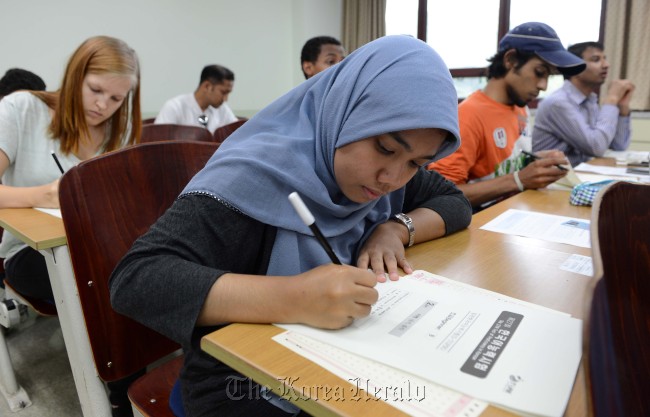More than 10,000 were enrolled at King Sejong Institutes ― Korea’s state-run Korean language institutes operating overseas ― last year, double the number of students registered when the language school was established in 2009, according to the Culture Ministry.
The institute was founded in 2009 with 4,301 students enrolled at 17 branches in six countries in 2009.
According to Ahn Mi-jung of the Korean Language Policy Division of the Culture Ministry, the language schools, also known as Sejong Hakdang, was established to serve the needs of Koreans living overseas.
The institute was founded in 2009 with 4,301 students enrolled at 17 branches in six countries in 2009.
According to Ahn Mi-jung of the Korean Language Policy Division of the Culture Ministry, the language schools, also known as Sejong Hakdang, was established to serve the needs of Koreans living overseas.

However, the number of non-Korean students has been growing rapidly in recent years as more become interested in Korean culture in response to hallyu, a Korean cultural wave including K-pop and K-dramas.
Sejong Hakdang’s L.A. branch, for example, did not receive many non-Korean students when it opened. At the time, 75 percent of its students were Korean-Americans. But this year, 74 percent of its students are non-Korean. At its basic-level classes, more than 90 percent of the students are non-Koreans.
“We hope to see those who are interested in Korea’s pop culture deciding to learn the Korean language, and those who learn the Korean language getting interested in Korea’s pop culture at the same time,” said a Korean Cultural Center Los Angeles official, who is in charge of running Sejong Hakdang’s L.A. branch.
“Aside from the hallyu effect, more people overseas are interested in learning the Korean language as many Korean corporations have entered the overseas market and therefore have created jobs for the locals,” the official said.
The institute currently has 76 branches in 35 countries, including 17 in China, five in Vietnam, four in the U.S., three in Russia and Turkey, and one in Nigeria.
The government plans to increase the number of Sejong Hakdang branches to 90 by the end of this year, and to 200 by the year 2016, the Culture Ministry said.
By Claire Lee (dyc@heraldcorp.com)












![[Today’s K-pop] BTS pop-up event to come to Seoul](http://res.heraldm.com/phpwas/restmb_idxmake.php?idx=644&simg=/content/image/2024/04/17/20240417050734_0.jpg&u=)




![[KH Explains] Hyundai's full hybrid edge to pay off amid slow transition to pure EVs](http://res.heraldm.com/phpwas/restmb_idxmake.php?idx=652&simg=/content/image/2024/04/18/20240418050645_0.jpg&u=20240419100350)

![[Today’s K-pop] Zico drops snippet of collaboration with Jennie](http://res.heraldm.com/phpwas/restmb_idxmake.php?idx=642&simg=/content/image/2024/04/18/20240418050702_0.jpg&u=)